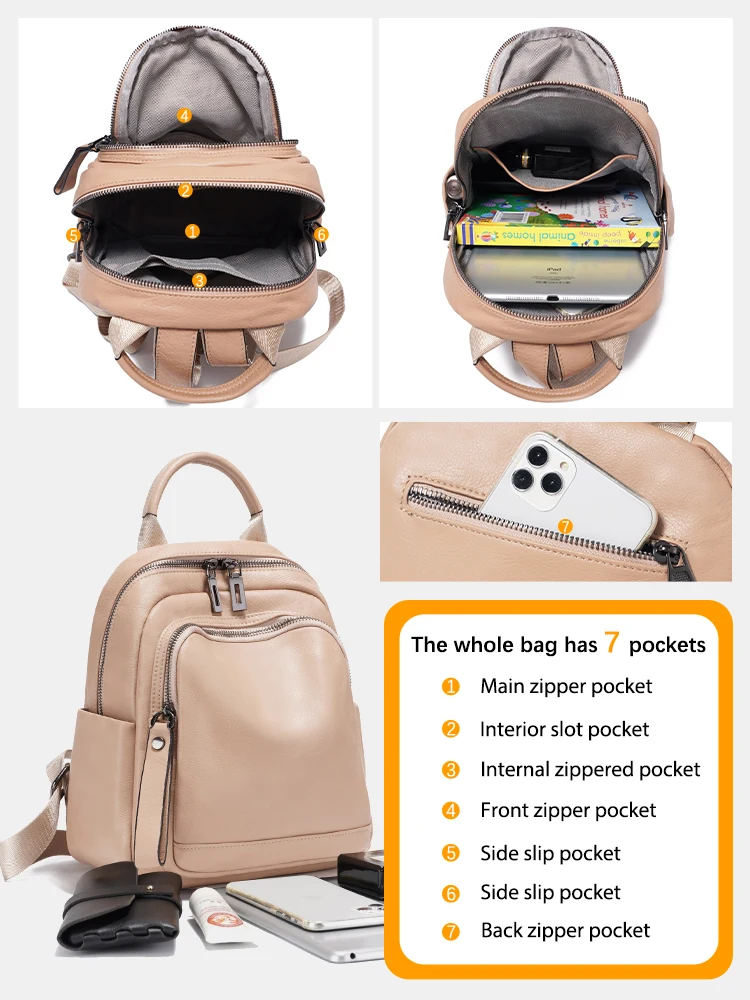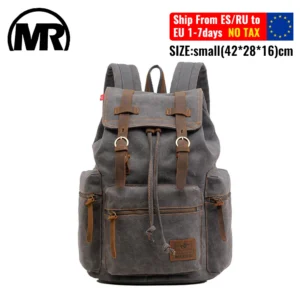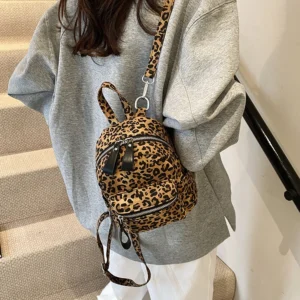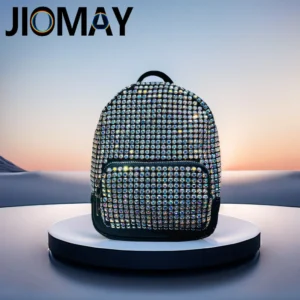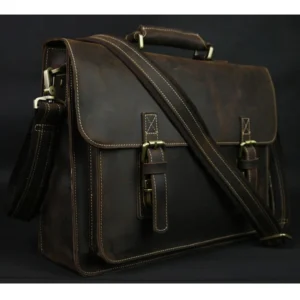Introduction: Understanding the Unique Challenges of Leather Backpacks
Leather backpacks represent a perfect blend of style, durability, and functionality. Unlike their synthetic counterparts, these premium accessories present unique organizational challenges that stem from their material properties and typically minimalist design. With fewer built-in compartments and dividers, leather backpacks require thoughtful organization to maximize their potential while preserving their elegant appearance.
Many leather backpack owners face common frustrations: frantically searching for items buried at the bottom, discovering pen marks on the interior lining, or watching in dismay as their beautifully structured bag loses shape due to improper packing. Poor organization can lead to stretched leather, damaged interior surfaces, and a significantly reduced lifespan of your investment piece.
Proper organization isn’t just about convenience—it’s about protecting and enhancing your leather backpack’s inherent qualities. A well-organized leather backpack maintains its sophisticated silhouette, prevents unnecessary wear, and ensures that the natural beauty of the leather remains uncompromised. Throughout this guide, we’ll explore practical strategies to transform your leather backpack into a masterpiece of efficiency while preserving its timeless elegance and applying proper leather conditioning and waterproofing techniques for long-term care.
Why Strategic Organization Matters for Leather Backpacks
Strategic organization transforms your leather backpack from a stylish accessory into a functional powerhouse. When everything has its place, you gain precious minutes in your day by eliminating the frustrating search for keys, cards, or other essentials. This efficiency doesn’t just save time—it preserves your peace of mind and professional composure in important moments.
Unlike synthetic materials, leather responds to how you treat it. Proper weight distribution prevents uneven stretching and maintains the backpack’s intended structure. When heavy items are placed thoughtfully at the bottom and against the back panel, the leather ages gracefully instead of developing unsightly bulges or premature wear points. Additionally, separating items prevents metal objects, keys, or pens from scratching or staining the interior.
The benefits of strategic organization extend to physical comfort as well. A properly packed leather backpack distributes weight evenly across your shoulders and back, reducing strain during commutes or travel. This balanced approach enhances comfort while maintaining the sleek, professional appearance that makes premium leather backpacks so appealing in the first place.
Key benefits of strategic organization include:
– Enhanced accessibility to everyday essentials
– Prevention of interior damage and premature wear
– Preservation of the backpack’s elegant silhouette and structure
– Improved comfort through balanced weight distribution
– Maintenance of a polished, professional appearance
Proper organization works hand-in-hand with regular leather conditioning to ensure your backpack remains beautiful for years to come.
Essential Organization Principles for Leather Backpacks
The Minimalist Approach
The foundation of excellent leather backpack organization begins with carrying only what you truly need. Leather backpacks, especially those of premium quality, aren’t designed for excessive weight or overcrowding. Before organizing, assess each item’s necessity and remove anything that doesn’t serve an immediate purpose. This disciplined approach not only makes organization easier but also prevents leather stretching and maintains the backpack’s elegant form.
Strategic Weight Distribution
How you distribute weight directly impacts both the longevity of your leather backpack and your physical comfort. Position the heaviest items—laptops, books, or water bottles—at the bottom of the bag and closest to your back. This placement lowers the center of gravity and reduces strain on the leather’s structure. Lighter items should occupy the top and outer areas of the backpack, creating a balanced load that won’t deform the leather or create unnecessary pressure points.
Material Protection
Leather interiors are more susceptible to scratches, stains, and damage than synthetic materials. Protect your investment by ensuring potentially harmful items never come into direct contact with leather surfaces. Keys, metal accessories, and pens should always be contained in protective cases or pouches. Cosmetics, snacks, and liquids require leak-proof containers to prevent devastating stains that can permanently damage even the finest leather.
Regular Rotation and Decluttering
Even the most carefully organized backpack requires regular maintenance. Establish a weekly routine to remove accumulated receipts, wrappers, and other unnecessary items. This habit prevents your carefully crafted organization system from deteriorating and eliminates excess weight that could strain the leather. Monthly reorganization allows you to reassess your carrying needs and adapt your system accordingly, ensuring your leather backpack continues serving you efficiently.
Maximizing Internal Space: Compartmentalization Strategies
Using Pouches and Organizers
The key to transforming a minimalist leather backpack into an organizational marvel lies in strategic compartmentalization. Small pouches and organizers create structure within unstructured spaces, making every inch of your backpack functional:
- Slim zippered pouches work best for documents, notebooks, and tablets
- Mesh organizers allow visibility of contents while containing small items
- Soft-sided containers conform to the backpack’s shape without creating rigid pressure points
- Color-coded pouches enable instant identification of contents without rummaging
Choose organizers made from soft materials like cotton, felt, or microfiber that won’t abrade the leather interior. Size is equally important—select pouches that fit comfortably without forcing the leather to stretch. The goal is to create internal structure while respecting the natural properties of the leather.
Creating Zones Within Your Backpack
Effective organization transforms your backpack into a system of intuitive zones, each serving a specific purpose:
Work/Productivity Zone: Position your laptop (in a protective sleeve), notebooks, and documents against the back panel for stability and protection. This zone benefits from firm, flat organizers that maintain document integrity.
Technology Zone: Designate a specific section for electronic accessories like chargers, batteries, adapters, and cables. Use cable organizers or small pouches to prevent tangling and make identification simple.
Personal Items Zone: Create a dedicated space for wallets, keys, sunglasses, and other personal essentials. This zone works best near the top or in external pockets for quick access without disrupting other zones.
Quick-Access Zone: Reserve the most accessible areas—typically top sections or front pockets—for items you need frequently throughout the day. This prevents constant reorganization of your primary compartments.
This zoning approach complements techniques for office backpack organization by creating a system that works seamlessly in professional environments.

Item-Specific Organization Solutions
Electronic Devices and Accessories
Electronic devices represent significant investments that deserve protection within your leather backpack:
- Use padded sleeves specifically sized for your laptop or tablet, even if your backpack has a dedicated laptop compartment, for added protection against bumps and scratches
- Employ elastic bands or dedicated cable organizers to prevent charger cables from tangling or creating pressure points in the leather
- Store power banks and adapters in dedicated pouches with internal padding to prevent movement and potential damage to your backpack’s interior
For those who regularly carry multiple electronic devices, leather laptop backpacks with built-in protection features offer additional organization benefits.
Daily Essentials
Everyday items require thoughtful placement for accessibility without sacrificing protection:
- Position wallets and phones in quick-access pockets lined with soft material to prevent scratches
- Use key cases or fobs to contain keys and prevent them from scratching both the bag’s interior and other items
- Store sunglasses in rigid cases positioned toward the top of the bag to prevent crushing
- Keep small, frequently used items like lip balm or hand sanitizer in external pockets for easy access without opening the main compartment
Work and Study Materials
Documents and writing materials present unique organizational challenges:
- Use slim document folders with internal divisions to prevent paper creasing and keep projects separated
- Store pens and markers in dedicated holders that prevent leakage and keep caps secure
- Position notebooks and planners vertically against the back panel to maintain their shape and prevent bent corners
- For presentations or important documents, consider rigid portfolio inserts that maintain crisp, professional appearance
Personal Care Items
These potentially messy items require extra containment measures:
- Use double-sealed containers for liquids, creams, and gels to prevent devastating leaks
- Place all toiletries in waterproof pouches separate from electronics and papers
- Position personal care items vertically when possible to minimize leakage risk
- Opt for solid alternatives to liquid products when available for travel and daily commutes
Utilizing External Features Effectively
While internal organization forms the foundation of an efficient leather backpack, external features provide valuable additional functionality when used strategically. External pockets serve best as homes for items you need to access quickly without disturbing your main compartment’s organization—transit cards, phone, keys, or small water bottles find their perfect home here.
Many premium leather backpacks feature subtle attachment points or straps that often go underutilized. These exterior features can secure items that are awkward to pack internally: umbrellas, yoga mats, or light jackets can be attached securely without compromising the backpack’s elegant appearance. The key is maintaining a balanced silhouette that doesn’t detract from the leather’s natural beauty.
Strategic use of external features enhances your waterproofing efforts for leather bags by keeping potentially wet items like umbrellas or water bottles outside the main compartment where they could damage contents. This separation protects both your belongings and the leather itself from unnecessary moisture exposure.
When utilizing external features, maintain balance in weight distribution. Overloading one side with heavy items can create uneven pressure on shoulder straps and seams, potentially damaging the leather over time and creating discomfort during wear.
Adapting Your Organization Strategy for Different Contexts
Daily Commute Configuration
For everyday commuting, efficiency and accessibility drive your organization strategy:
- Prioritize quick-access items in external pockets or top sections
- Position daily essentials (wallet, phone, transit card) in consistent, easily reachable locations
- Create a compact technology setup with only essential chargers and accessories
- Establish a designated spot for commute-specific items like headphones and water bottles
- Remove unnecessary items daily to maintain a lightweight, streamlined profile
Business Travel Organization
Business travel demands a more comprehensive organization approach:
- Create separate zones for work materials, personal items, and travel documents
- Use document organizers with multiple compartments to keep presentations and papers pristine
- Position formal accessories (ties, jewelry) in protective cases away from items that could cause damage
- Arrange technology and charging accessories in easily accessible configurations for security screenings
- Include versatile items that transition between different business settings without requiring reorganization
Weekend or Leisure Travel Setup
Leisure travel introduces different organizational priorities:
- Implement packing cube systems that maximize space while keeping clothing organized
- Create specific zones for activity-based gear (hiking accessories, beach items, or city exploration tools)
- Position snacks and hydration in easily accessible areas for on-the-go energy
- Use compression techniques for soft items to maximize available space
- Incorporate flexible organization systems that adapt to souvenirs or unexpected purchases
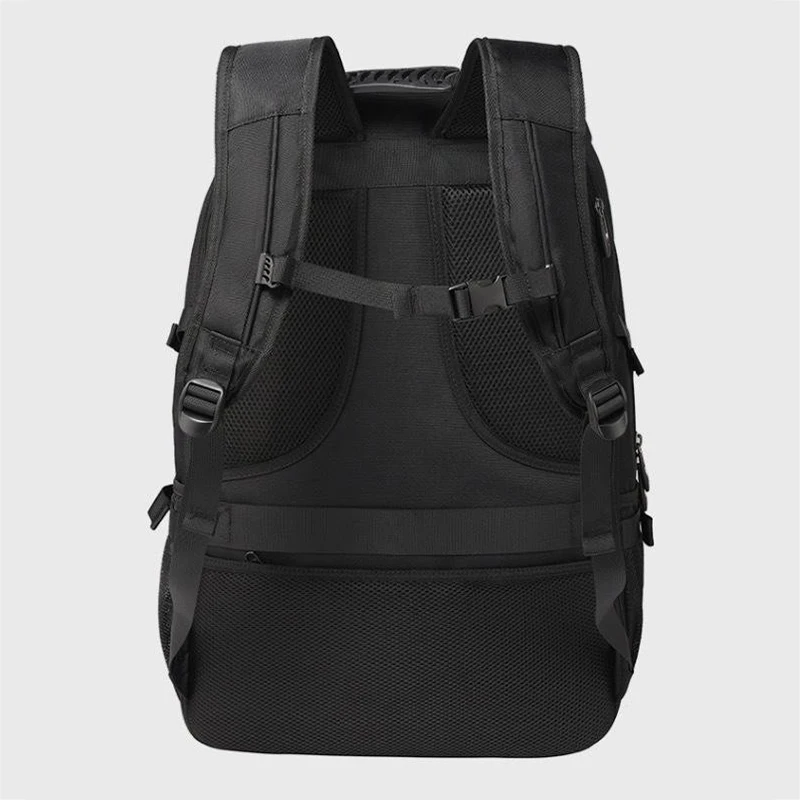
These context-specific strategies complement techniques for packing essentials in leather day bags when you need to transition between different daily scenarios with minimal reorganization.
Protecting Your Leather Backpack Through Organization
Proper organization serves a dual purpose: enhancing functionality while protecting your investment. Leather, as a natural material, responds to how it’s treated, making thoughtful organization essential for longevity.
Interior scratches represent one of the most common yet preventable forms of damage. Metal objects like keys, pen clips, or jewelry can permanently mark leather surfaces when allowed to move freely. Always contain these items in protective pouches positioned away from the backpack’s leather walls. Even better, designate specific pockets for potentially abrasive items to create consistent protection zones.
Maintaining your backpack’s elegant shape depends significantly on how you pack it. Distribute weight evenly throughout the bag rather than concentrating heavy items in one area. This prevents the leather from stretching unevenly and preserves the designed silhouette. When not in use, lightly stuff your backpack with soft materials to help it retain its shape without creating pressure points.
Moisture protection requires particular attention with leather. Position any potentially leaky items in waterproof containers and keep them centered in your bag, away from seams where liquid could escape and damage the leather. Develop the habit of maintaining your leather backpack regularly, which includes proper organization as a key component of preservation.
Key protective organization strategies include:
– Using protective sleeves for all electronics and sharp objects
– Implementing padding between hard items that could create pressure points
– Avoiding overstuffing that forces leather to stretch beyond its natural capacity
– Creating barriers between potentially damaging items and leather surfaces
– Removing all contents when storing the backpack for extended periods
Essential Organization Tools and Accessories
The right accessories transform even the most minimalist leather backpack into an organizational masterpiece:
Slim Packing Cubes: Unlike bulky travel cubes, slim versions designed specifically for backpacks provide structure without rigidity. Look for cubes with compression features in various sizes to categorize items effectively while maximizing space.
Cable Organizers: Tangled cables create unnecessary bulk and can damage both the cables and your backpack’s interior. Dedicated cable wraps, small elastic organizers, or even simple velcro ties keep technology accessories neatly contained and easily accessible.
Document Folios: Thin, flexible document organizers protect important papers without adding significant bulk. Models with multiple internal pockets allow for document categorization while maintaining a slim profile that conforms to the backpack’s shape.
Modular Insert Systems: These adaptable organizers transform unstructured compartments into customized storage solutions. Look for inserts made from flexible materials that protect contents without creating rigid pressure points that could damage leather over time.
Dedicated Pen Cases: Prevent ink stains and scratches with slim pen cases that contain multiple writing instruments securely. Models with elastic loops keep pens accessible while preventing movement during transit.
Water-Resistant Pouches: Protect your backpack’s interior from potential leaks by containing toiletries, water bottles, or food items in waterproof pouches positioned centrally in your bag, away from leather surfaces.
For those seeking backpacks with thoughtful built-in organization, women’s leather backpacks often feature intelligently designed internal compartments that complement these accessories.
14 Inch Leather Laptop Backpack, Brown Leather Backpack, Men's Leather Backpack, Vintage Leather Backpack
Price range: $177.28 through $199.12 Select options This product has multiple variants. The options may be chosen on the product pageCarry On Leather Backpack, Roll Top Leather Backpack
Price range: $77.76 through $96.48 Select options This product has multiple variants. The options may be chosen on the product pageDesigner Men's Backpack, Men's Leather Laptop Backpack, Men's Leather Work Backpack
Price range: $158.04 through $160.04 Select options This product has multiple variants. The options may be chosen on the product pageDesigner Mini Backpack, Mini Leather Backpack, Small Leather Sling Backpack, Women's Leather Backpack
Price range: $95.76 through $98.80 Select options This product has multiple variants. The options may be chosen on the product pageDesigner Mini Backpack, Designer Women's Backpack, Mini Leather Backpack, Women's Leather Backpack
Price range: $135.92 through $137.64 Select options This product has multiple variants. The options may be chosen on the product page15 Inch Leather Laptop Backpack, Leather Briefcase Backpack
$332.96 Select options This product has multiple variants. The options may be chosen on the product page
DIY Organization Hacks for Leather Backpacks
Creating effective organization doesn’t always require specialized products. These DIY solutions offer budget-friendly alternatives that respect your leather backpack’s premium nature:
Custom Dividers: Transform sturdy cardboard covered with felt or soft fabric into custom-sized dividers. Cut the cardboard to fit your backpack’s dimensions, cover completely with fabric using fabric glue, and insert vertically to create separated sections. This technique works particularly well for organizing notebooks, tablets, or documents.
Repurposed Containers: Small mint tins, cleaned makeup containers, or spectacle cases make excellent organizers for small items. Line metal containers with felt or microfiber to prevent scratching other items and contain small accessories like earbuds, memory cards, or jewelry.
Elastic Band Systems: Create a customized organization system using wide elastic bands sewn together to form loops of various sizes. This flexible system can be adjusted to hold different items securely while adding minimal weight and bulk to your backpack.
Fabric Pocket Panels: Sew multiple pockets onto a fabric panel that can be rolled up when not in use. This removable organization system can be customized to your specific needs and transferred between different bags, making it ideal for travelers who use various DIY leather care techniques for travel backpacks.
Sock Organizers: Clean, cut socks create perfect protective sleeves for sunglasses, small electronics, or fragile items. Their soft, stretchy material conforms to oddly shaped objects while providing cushioning against impacts.
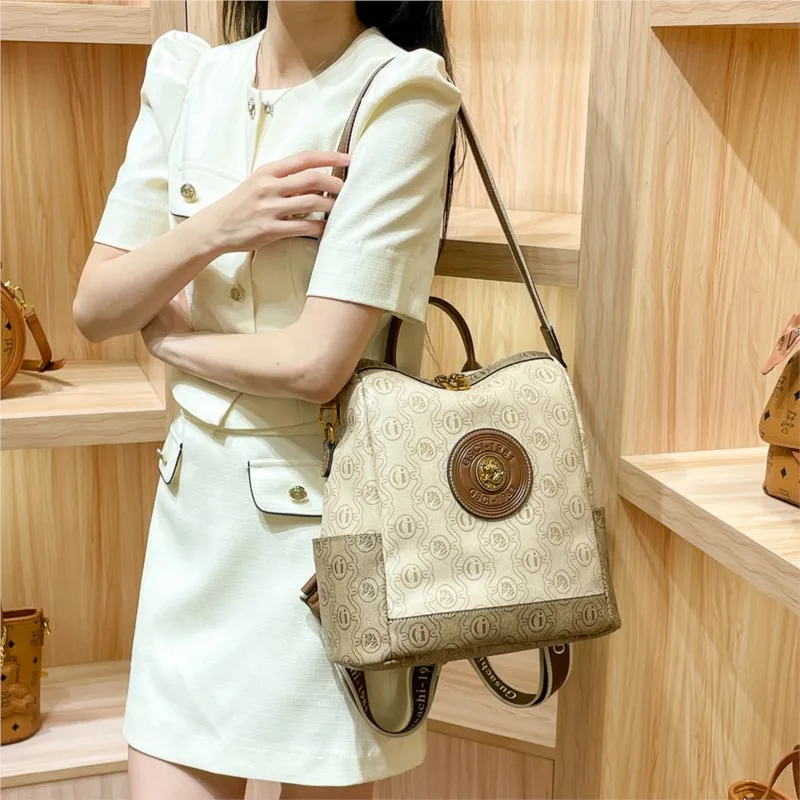
What Not to Do: Organization Mistakes That Damage Leather Backpacks
Avoiding these common organization mistakes will significantly extend your leather backpack’s lifespan:
Overstuffing Beyond Capacity: Forcing too many items into your backpack stretches the leather beyond its natural elasticity, potentially causing permanent deformation. Respect the bag’s intended capacity and choose items strategically.
Storing Sharp Objects Unprotected: Keys, pens, or tools placed directly against leather surfaces create scratches that cannot be repaired. Always use protective cases or designated pockets for anything with edges or points.
Using Rigid Organizers: Hard plastic containers create pressure points that can deform leather over time. Opt for soft, flexible organizers that work with the leather’s natural properties rather than against them.
Neglecting Weight Distribution: Consistently packing heavy items on one side creates uneven strain, potentially damaging stitching and altering the backpack’s shape permanently. Balance weight evenly throughout the bag.
Storing Food Without Protection: Even sealed snacks can leak oils or create odors that penetrate leather. Always use separate containers for any food items and keep them isolated from the backpack’s interior surfaces.
These precautions are particularly important for full-grain leather backpacks, as their natural finish showcases both the leather’s beauty and any damage more prominently than treated leathers.
Maintaining Your Organization System
Even the most thoughtfully designed organization system requires regular maintenance to function effectively. Establish a weekly cleanout routine where you remove all contents, dispose of accumulated trash, and reassess each item’s necessity. This simple habit prevents organizational drift and ensures your system continues working as intended.
Seasonal transitions provide perfect opportunities for more comprehensive reorganization. As your carrying needs change with the seasons—more layers in winter, hydration focus in summer—adjust your organizational approach accordingly. This adaptability ensures your leather backpack continues serving your evolving needs efficiently.
Consider implementing these maintenance practices:
- Weekly removal of unnecessary receipts, wrappers, and papers
- Monthly reassessment of pouches and containers for effectiveness
- Quarterly deep cleaning of all organizational accessories
- Seasonal adjustment of your system based on changing needs
These maintenance principles apply equally to larger bags and small leather backpack organization, though with different space constraints to consider.
Is Investing in a Pre-Organized Leather Backpack Worth It?
Q: What advantages do built-in organization features offer?
A: Pre-organized leather backpacks provide thoughtfully designed compartments specifically sized for common items like laptops, tablets, and phones. These purpose-built features often include protective padding and optimal positioning for weight distribution. For professionals who carry the same items daily, these consistent organization systems eliminate guesswork.
Q: What limitations might built-in organization present?
A: Fixed compartments lack adaptability to changing needs. A backpack with rigid organization designed for specific electronics may not accommodate newer models or different items if your carrying requirements change. Some users find predetermined compartments restrictive when they need to carry unusual or oversized items.
Q: How should I balance organization with aesthetic considerations?
A: The most elegant leather backpacks often feature cleaner, more minimalist designs with fewer visible organization features. Consider whether visible organizational elements (like external pockets or compartments) enhance or detract from the aesthetic appeal you’re seeking. The most versatile options offer subtle, thoughtful organization that doesn’t compromise the backpack’s streamlined appearance.
How Does Weather Affect Your Leather Backpack Organization?
Rainy conditions demand a modified organization approach to protect both your belongings and the leather itself. Position electronic devices and important documents in the center of your bag, surrounded by less vulnerable items that create a protective buffer. Consider adding a dedicated waterproof pouch for essential items that must remain completely dry, even if your backpack’s exterior becomes saturated.
Hot weather introduces different challenges, particularly regarding items that might be affected by heat. Keep cosmetics, medications, and electronic devices toward the center of your bag where they’re insulated from external temperatures. Additionally, maintain some breathing room in your organization system as leather can become more supple and potentially stretch in high temperatures.
Cold weather typically requires carrying additional items like gloves, scarves, or hand warmers. Create a specialized “winter essentials” pouch that keeps these items together and easily accessible without disrupting your core organization system. Position this pouch near the top of your backpack for quick access without exposing the entire contents to cold air when retrieving items.
Do Different Types of Leather Require Different Organization Approaches?
Full-grain leather, with its natural surface character and durability, generally handles weight distribution better than more processed leathers. However, its natural finish means scratches from unprotected sharp objects remain more visible, making interior protection particularly important. Organization systems for full-grain leather backpacks should emphasize protection while taking advantage of the material’s natural strength.
Structured leather backpacks maintain their shape regardless of contents, allowing for more flexible organization approaches. Their rigid form creates natural separation between items even without additional organizers. In contrast, unstructured leather backpacks rely heavily on your organization system to maintain their shape and appearance, making strategic placement of items essential.
Vintage or aged leather requires gentler treatment as the material has typically softened over time. Organization systems should avoid creating pressure points or stretching already supple leather. Lighter-weight organizers distributed evenly throughout the bag help preserve the leather’s character while maintaining functionality.
How Can Organization Enhance Your Leather Backpack’s Aesthetic Appeal?
A well-organized leather backpack maintains its intended silhouette, allowing the designer’s vision to shine through without distortion. When contents are thoughtfully arranged, the backpack retains its elegant lines and proportions, whether it’s a structured briefcase-style design or a more casual daypack. This shape integrity significantly enhances visual appeal and professional presentation.
Strategic organization prevents the unsightly bulging and asymmetry that results from haphazard packing. By distributing weight evenly and using appropriate organizers, your leather backpack maintains a balanced, intentional appearance that complements its premium material. This balanced profile not only looks better but also helps the leather age more uniformly, developing character rather than premature wear spots.
Consider organizational accessories that complement your backpack’s aesthetic—leather pouches in coordinating colors, brass or gold-toned cable organizers, or natural fabric containers. These thoughtfully selected accessories enhance both function and appearance, creating a cohesive look that elevates your leather backpack from merely practical to truly sophisticated. This attention to detail transforms organization from a purely functional concern into another expression of your personal style.

